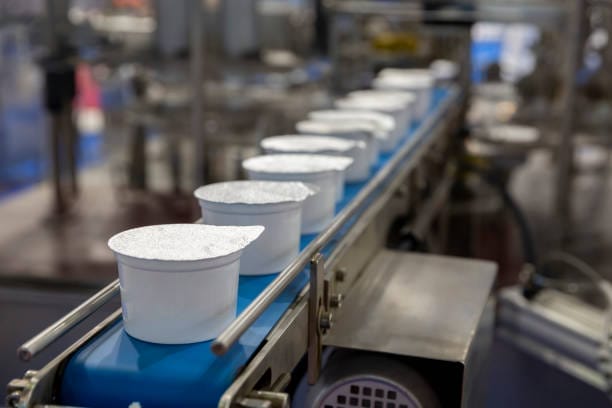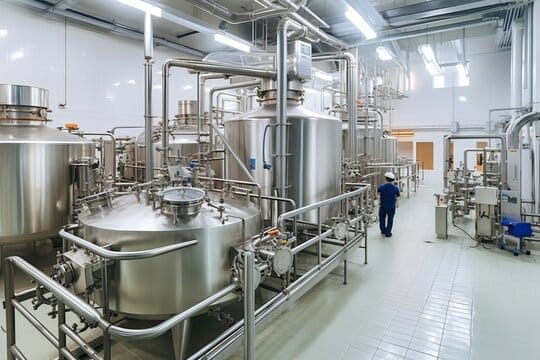In dairy processing, maintaining hygiene and managing scale are critical to efficiency, product consistency, and food safety. One of the most persistent issues is milk-stone, a hard deposit made up of minerals and proteins that accumulates on equipment. Traditionally, water is treated to minimise scaling risks, but what if you could apply advanced technology directly to the dairy liquid itself?
This article explores a novel approach: using the Sidon Integro™ to restructure the dairy liquid directly, and answers two questions:
1. Can the Integro™ prevent and remove milk-stone when dairy itself passes through it?
2. Will this restructuring affect how milk behaves during cheese, yoghurt, and butter production?
What Is Milk-Stone?
Milk-stone is a white or grey deposit formed by the interaction of:
· Calcium and magnesium salts
· Protein residues
· Fat and phosphate compounds
It occurs primarily in areas where milk is heated or agitated, such as pasteurisers and pipelines, causing significant cleaning challenges and increasing the risk of bacterial contamination.
What Happens When Dairy Is Passed Through the Integro™?
Traditionally, the Sidon Integro™ is used to restructure water by injecting free electrons into the flow, altering ionic interactions. When milk or other dairy liquids pass through the Integro™ device:
· Free electrons are introduced into the liquid matrix, interacting with calcium (Ca²⁺), magnesium (Mg²⁺), and other charged particles.
· This creates a temporary reduction in ionic bonding capacity, meaning scale-forming reactions like Ca²⁺ + CO₃²⁻ → CaCO₃ are suppressed.
· Proteins and colloids within the milk acquire a stronger surface charge, remaining in suspension more readily and being less prone to adhering to metal surfaces.
This restructuring doesn’t change the milk’s chemical composition but affects how particles behave within it.
Does This Prevent or Remove Milk-Stone?
Yes – when dairy itself is restructured by the Integro™, it can directly inhibit the formation of milk-stone.
· Calcium carbonate and magnesium deposits are less likely to form, even under heat.
· Proteins and fats remain more suspended, reducing adhesion to surfaces.
· Any scale that does begin to form is less dense and more easily cleaned, due to interference with crystallisation pathways.
· Over time, existing milk-stone may soften and break down, especially when combined with good CIP protocols.
How Does Restructuring Affect Dairy Processing?
One might reasonably ask—if you change the behaviour of calcium and proteins in milk, will that disrupt cheese-making or fermentation? Here’s what happens:
1. Milk Chemistry Is Not Permanently Altered
The restructuring from the Integro™ is temporary and non-invasive. It doesn’t add chemicals, remove minerals, or change pH levels. Once milk exits the treatment zone:
· Ions like Ca²⁺ gradually return to their natural state.
· The physical structure of milk proteins normalises.
2. Cheese and Yoghurt Production Behaves Normally
Cheese-making and yoghurt production rely on:
· Rennet activity
· Lactic acid fermentation
· Protein coagulation
These processes are driven by enzyme-substrate interactions and pH shifts. Since the Integro™ does not interfere with pH or protein structure beyond transient electrostatic effects, casein micelles coagulate as expected, and culture activity proceeds unhindered.
3. No Adverse Effects on Taste, Texture or Yield
The physical restructuring does not result in any chemical residues, taste changes, or modifications to fat separation. In trials and theory, milk that has passed through the Integro™ yields cheese, butter, and yoghurt of the same quality as untreated milk.
4. Enhanced Cleanability and Shelf-Life Potential
Because the dairy liquid is less prone to fouling surfaces, equipment stays cleaner, reducing the chance of biofilm formation and microbial cross-contamination. This can indirectly support longer run times and better microbial control, which is beneficial to shelf-life stability.
Real-World Application: Restructuring Milk at Scale
Imagine a dairy facility running at 35°C with high calcium content (600–1,200 mg/L) and a processing rate of 400 m³/h. If the raw milk passes through the Integro™ immediately after arrival:
· Calcium ions are momentarily neutralised, delaying their ability to form scale.
· Fat globules and protein micelles gain charge and stay suspended longer.
· This restructuring phase aligns with pasteurisation and homogenisation, optimising cleanliness without compromising functionality.
Even after the restructuring effect dissipates, the milk has already bypassed the risk zone for scale formation, allowing for cleaner downstream operations.
Conclusion
Using the Sidon Integro™ to restructure dairy liquids directly offers a novel method for preventing milk-stone, improving equipment hygiene, and preserving product quality. Unlike chemical additives or mechanical softeners, this approach is non-invasive, energy-efficient, and maintenance-free.
· Milk-stone formation is suppressed at the point of risk.
· Milk composition and behaviour in cheese, yoghurt, and butter production remain unaffected.
· Equipment cleaning becomes easier, and biofouling is reduced.
This opens new possibilities for dairies seeking cleaner processes without compromising the quality or authenticity of their products.
If you’re exploring new ways to reduce milk-stone while enhancing the cleanliness of your production line, consider using the Sidon Integro™ to restructure dairy liquids directly. Contact us today to discuss pilot testing in your facility and find out how this innovative approach could transform your dairy operations.


